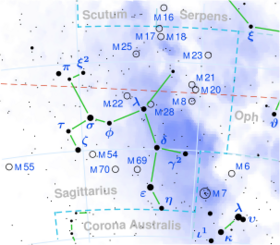Astronomy:43 Sagittarii
| Observation data Equinox J2000.0]] (ICRS) | |
|---|---|
| Constellation | Sagittarius |
| Right ascension | 19h 17m 38.07906s[1] |
| Declination | −18° 57′ 10.4626″[1] |
| Apparent magnitude (V) | 4.88[2] |
| Characteristics | |
| Spectral type | G8II-III[3] |
| U−B color index | +0.81[4] |
| B−V color index | +1.02[4] |
| Astrometry | |
| Radial velocity (Rv) | +15.20[5] km/s |
| Proper motion (μ) | RA: −10.341[1] mas/yr Dec.: −10.892[1] mas/yr |
| Parallax (π) | 6.9681 ± 0.1875[1] mas |
| Distance | 470 ± 10 ly (144 ± 4 pc) |
| Absolute magnitude (MV) | -0.96[2] |
| Details[6] | |
| Mass | 3.30 M☉ |
| Radius | 23.99 R☉ |
| Luminosity | 277 L☉ |
| Surface gravity (log g) | 2.22 cgs |
| Temperature | 4,813 K |
| Metallicity [Fe/H] | −0.18 dex |
| Rotational velocity (v sin i) | 4.2[7] km/s |
| Age | 350±100[8] Myr |
| Other designations | |
| Database references | |
| SIMBAD | data |
43 Sagittarii is a single[10] star in the southern constellation of Sagittarius. It has the Bayer designation d Sagittarii, while 43 Sagittarii is the Flamsteed designation.[9] This object is visible to the naked eye as a faint, yellow-hued star with an apparent visual magnitude of 4.88.[2] From parallax measurements, it is estimated to lie around 470 light years away from the Sun.[1] The star is drifting further from the Earth with a heliocentric radial velocity of +15.2 km/s.[5] It is located near the ecliptic and thus is subject to lunar occultations.[11]
This is an aging giant/bright giant star with a stellar classification of G8II-III,[3] and is most likely (97% chance) on the horizontal branch.[8] It is around 350[8] million years old with 3.3[6] times the mass of the Sun. Having exhausted the supply of hydrogen at its core, the star has expanded to 24[6] times the Sun's radius and is now generating energy through core helium fusion. It is radiating 277 times the luminosity of the Sun from its swollen photosphere at an effective temperature of 4,813 K.[6]
References
- ↑ 1.0 1.1 1.2 1.3 1.4 1.5 Brown, A. G. A. (August 2018). "Gaia Data Release 2: Summary of the contents and survey properties". Astronomy & Astrophysics 616: A1. doi:10.1051/0004-6361/201833051. Bibcode: 2018A&A...616A...1G. Gaia DR2 record for this source at VizieR.
- ↑ 2.0 2.1 2.2 Anderson, E.; Francis, Ch. (2012). "XHIP: An extended hipparcos compilation". Astronomy Letters 38 (5): 331. doi:10.1134/S1063773712050015. Bibcode: 2012AstL...38..331A. Vizier catalog entry
- ↑ 3.0 3.1 Hoffleit, D.; Warren, W. H. (1995). "Bright Star Catalogue". VizieR On-line Data Catalog: V/50. Originally Published in: 1964BS....C......0H 5050. Bibcode: 1995yCat.5050....0H.
- ↑ 4.0 4.1 Mermilliod, J. C. (2006). "Homogeneous Means in the UBV System (Mermilliod 1991)". VizieR On-line Data Catalog: II/168. Originally Published in: Institut d'Astronomie 2168. Bibcode: 2006yCat.2168....0M.Vizier catalog entry
- ↑ 5.0 5.1 Wilson, R. E. (1953). "General Catalogue of Stellar Radial Velocities". Carnegie Institute Washington D.C. Publication (Carnegie Institution for Science). ISBN 9780598216885. Bibcode: 1953GCRV..C......0W.
- ↑ 6.0 6.1 6.2 6.3 Reffert, Sabine et al. (2015). "Precise radial velocities of giant stars". Astronomy & Astrophysics 574: A116. doi:10.1051/0004-6361/201322360. Bibcode: 2015A&A...574A.116R. Vizier catalog entry
- ↑ De Medeiros, J. R.; Alves, S.; Udry, S.; Andersen, J.; Nordström, B.; Mayor, M. (2014). "A catalog of rotational and radial velocities for evolved stars". Astronomy & Astrophysics 561: A126. doi:10.1051/0004-6361/201220762. Bibcode: 2014A&A...561A.126D. Vizier catalog entry
- ↑ 8.0 8.1 8.2 Stock, Stephan et al. (August 2018), "Precise radial velocities of giant stars. X. Bayesian stellar parameters and evolutionary stages for 372 giant stars from the Lick planet search", Astronomy & Astrophysics 616: 15, doi:10.1051/0004-6361/201833111, A33, Bibcode: 2018A&A...616A..33S.
- ↑ 9.0 9.1 "d Sgr". SIMBAD. Centre de données astronomiques de Strasbourg. http://simbad.u-strasbg.fr/simbad/sim-basic?Ident=d+Sgr.
- ↑ Eggleton, P. P.; Tokovinin, A. A. (September 2008). "A catalogue of multiplicity among bright stellar systems". Monthly Notices of the Royal Astronomical Society 389 (2): 869–879. doi:10.1111/j.1365-2966.2008.13596.x. Bibcode: 2008MNRAS.389..869E.
- ↑ Richichi, A. et al. (May 1996). "New binary stars discovered by lunar occultations. II.". Astronomy and Astrophysics 309: 163–170. Bibcode: 1996A&A...309..163R.
 |


